Abstract
Magnesium hydride (MgH2) has received outstanding attention as a safe and efficient material to store hydrogen because of its 7.6 wt.% hydrogen content and excellent reversibility. Nevertheless, the application of MgH2 is obstructed by its unfavorable thermodynamic stability and sluggish sorption kinetic. To overcome these drawbacks, ball milling MgH2 is vital in reducing the particle size that contribute to the reduction of the decomposition temperature. However, the milling process would become inefficient in reducing particle sizes when equilibrium between cold-welding and fracturing is achieved. Therefore, to further ameliorate the performance of MgH2, nanosized cobalt titanate (CoTiO3) has been synthesized using a solid-state method and was introduced to the MgH2 system. The different weight percentages of CoTiO3 were doped to the MgH2 system, and their catalytic function on the performance of MgH2 was scrutinized in this study. The MgH2 + 10 wt.% CoTiO3 composite presents the most outstanding performance, where the initial decomposition temperature of MgH2 can be downshifted to 275 °C. Moreover, the MgH2 + 10 wt.% CoTiO3 absorbed 6.4 wt.% H2 at low temperature (200 °C) in only 10 min and rapidly releases 2.3 wt.% H2 in the first 10 min, demonstrating a 23-times-faster desorption rate than as-milled MgH2 at 300 °C. The desorption activation energy of the 10 wt.% CoTiO3-doped MgH2 sample was dramatically lowered by 30.4 kJ/mol compared to undoped MgH2. The enhanced performance of the MgH2–CoTiO3 system is believed to be due to the in situ formation of MgTiO3, CoMg2, CoTi2, and MgO during the heating process, which offer a notable impact on the behavior of MgH2.
1. Introduction
In recent decades, hydrogen has emerged as the most viable energy carrier, especially in the transportation sector [1]. As far as we are concerned, the usage of fossil fuels has led to a global energy crisis and environmental pollution [2]. Thus, energy transition from fossil fuel-based to renewable energy is required. As environmentally-friendly energy storage, the best solution is to convert energy from “green” sources into chemical storage [3]. Hydrogen has received outstanding interest as an energy carrier because it has a high energy content (142 MJ/kg) [4]. Hydrogen might supersede natural gas and solid fuels as an energy source by 2050. It is anticipated that it will be extensively used in the transportation, chemical, and long-term aviation and maritime sectors [5]. The use of hydrogen as an energy carrier will ultimately aid humankind in achieving a “low” or “zero” carbon future. Recently, various countries have started using hydrogen energy, particularly in transportation. For instance, the Hyundai Nexo hydrogen fuel cell vehicle (FCV) sold 1000 units in South Korea in 2019 [6], and the company is also setting up a number of hydrogen refueling stations [7]. Nevertheless, hydrogen-based energy requires a convenient and a reliable method of storing energy. How to store hydrogen is a vital phase for delivering a stock of hydrogen fuel to consumers for energy storage, fuel cell vehicles, stationary applications, and portable devices.
Commonly, hydrogen can be stored in three different forms, namely, (i) gas, (ii) liquid, and (iii) solid-state. The current hydrogen storage method for compressing gas requires high pressure, which is in the range of 350–700 bar H2 at room temperature, whereas liquid-form storage needs low temperature for the operation (−253 °C) [8,9]. The solid-state form appears to be the most effective technique compared to gas and liquid hydrogen because it has several benefits, including safety, high hydrogen capacity, modest working pressures, and excellent energy efficiency [10,11,12]. Throughout the last several decades, various types of solid-state material have been discovered. The solid-state approach of storing hydrogen has two techniques, namely, chemisorption and physisorption [13]. As a hydrogen storage technique, chemisorption in metal hydrides has drawn considerable attention. The advantage of this approach is that it can store a large amount of hydrogen in a small volume [14].
Among the various solid-state materials explored for hydrogen storage, MgH2 has been regarded as a viable option to store hydrogen for onboard applications on the strength of its high hydrogen capacity (7.6 wt.%), high energy density (9 MJ/kg) over all the reversible hydrides, and outstanding reversibility [15]. However, the obstacles of MgH2 for practical application include high temperature (>400 °C) to release hydrogen, sluggish sorption kinetics, and very stable thermodynamic properties (ΔH = 76 kJ/mol H2) [16,17]. To tackle these drawbacks, several efforts, such as nanostructuring, nanoconfinement, alloying, and the addition of catalyst [18,19,20,21] have been proposed and developed to modify the Mg-based system performances. In this study, the center of interest is to reduce the decomposition temperature and improve the kinetics performance of MgH2 by adding catalysts. Adding metal oxide [22,23,24], metal [25,26], metal halides [27], carbon material [28,29], and nanosized alloys [30,31] to MgH2 as catalysts have been highlighted as notable approaches to boost its hydrogen storage performance.
Among the catalysts, metal oxide has attracted growing interest because of its profound influence on the behavior of MgH2. Moreover, transition metals and their compounds have been proven to ease hydrogen dissociation and recombination [32]. Transition metals and their oxides are able to provide more sites for Mg and MgH2 nucleation, which ameliorates the hydrogen sorption kinetics [33]. Moreover, these transition metal oxide are easily reduced and converted into low-valence transition metal oxide or hydride due to the high reductivity of Mg/MgH2, which has been identified as a promising catalyst for dehydrogenation of MgH2 [34]. This is due to the significant interaction between the s-states of H and the d-states of low-valence transition metals, which could weaken the Mg-H bonds of MgH2 and enhance its reversible hydrogen storage performance. As reported by the earliest study, doping Ti, Mn, V, Fe, and Ni presents a rapid desorption process of MgH2 [35]. Thereafter, another series of transition metals, Co, Cu, and Nb, display remarkable catalytic function on the hydrogen release of MgH2 [36,37]. It is predicted that the oxides of transition metals proffer efficient catalytic activity on the performance of MgH2. For instance, adding TiO2 could speed up the absorption and desorption process of MgH2, enable the absorption of 5.3 wt.% H2 in only 44 s, and release 6.4 wt.% H2 in 700 s. Moreover, Yan et al. [38] demonstrated that adding NiTiO3 could lower the temperature for the release of hydrogen as well as the activation energy of MgH2 and result in faster hydrogen desorption and absorption. Furthermore, Shan et al. [39] reported that the presence of CoFe2O4 could speed up the hydrogen dehydriding of MgH2. The composite sample of MgH2 + 9 mol CoFe2O4 began to decompose at 150 °C, which was lower than undoped MgH2 (340 °C), and it is capable of desorbing 6.11 wt.% H2. Then, Ismail et al. [40] conducted a further study on transition metal oxide. The addition of CuFe2O4 could reduce the temperature for release hydrogen from 340 °C to 250 °C. They concluded that the enhancement of the MgH2 behavior was due to the formation of MgO, Fe and Mg–Cu alloy that accelerates the hydrogen desorption of MgH2. Therefore, transition metal oxide catalysts are favorable in ameliorating the hydrogen storage behavior of MgH2 by boosting the electron transfer between Mg and H [32].
In this study, it is of interest to examine the catalytic activity of another transition metal oxide, CoTiO3. What is noteworthy, is that the catalytic efficiency is influenced by the dispersion of catalytic activity on the system. Nanocatalysts offer noticeably more active catalytic sites and intimate interaction because of their increased surface area. Thus, in this study, we synthesized nanosized CoTiO3 via a solid-state method. The addition of CoTiO3 was projected to remarkably boost the behavior of MgH2 by lowering the initial decomposition temperature and rapid hydrogen absorption/desorption kinetics. Although there is a previous study reported on the effect of CoTiO3 [41], there remains a lack of mechanism of interaction between MgH2 and CoTiO3. Furthermore, different synthesis methods present different catalytic activities. This study broadens the way to explore the effect of CoTiO3 and demonstrates the different catalytic activities of CoTiO3 on the hydrogen storage behavior of MgH2. Hence, in this paper, the influence of different weight percentages of CoTiO3 was systematically explored.
2. Materials and Methods
MgH2 (95% pure), Co3O4 (99.99% pure), anatase TiO2 (99.95% pure), and citric acid monohydrate (>98% pure) provided by Sigma Aldrich, St. Louis, MO, United States were used without any pretreatment. The nanosized CoTiO3 was synthesized using the solid-state method. The stoichiometric amount of Co3O4 and TiO2 were ground together for 15 min. Thereafter, citric acid monohydrate was added and continuously ground for 15 min. The powder was then calcined at 850 °C for 5 h. Thereafter, different weight percentages of CoTiO3 (5, 10, 15, and 20 wt.%) were added with MgH2 to study its catalytic activity on the hydrogen storage behavior of MgH2. The mixture was milled together in a planetary ball mill (NQM-0.4) at 400 rpm for 1 h.
Sievert-type pressure-composition-temperature apparatus from Advanced Materials Corporation, Pittsburgh, PA, United States which is also known as Gas Reaction Controller (GRC) apparatus, was used to conduct the temperature-programmed desorption (TPD) measurement and the hydrogen absorption and desorption experiment. The GRC provides a reliable and convenient way to evaluate desorption/absorption characteristics of materials. Temperature, capacity, and time data obtained through TPD measurements were used to determine the capacity, kinetics, and thermodynamic properties of material. The TPD measurement was conducted in a vacuum chamber heated to 450 °C (heating rate: 5 °C /min). For the isothermal tests, experiments were conducted at 200 °C, 33.0 atm hydrogen pressure (absorption kinetics), and 300 °C, 1.0 atm hydrogen pressure (desorption kinetics).
To study the thermal properties and to calculate the activation energy, differential scanning calorimetry (DSC, Mettler Toledo, Columbus, OH, United States)(DSC/TGA 1) was used. Six to eight milligrams of the sample were placed in a crucible and heated to 500 °C under an argon flow of 50 mL/min at four different heating rates (15 °C/min, 20 °C/min, 25 °C/min, and 30 °C/min). Rigaku MiniFlex, Tokyo, Japan, X-ray diffraction (XRD) with Cu Kα radiation was used to examine the phase structure. The patterns were scanned over diffraction angles from 20° to 80° at 2.00°/min. The sample microstructure and morphology were examined using a scanning electron microscope (SEM; JEOL, Akishima, Tokyo, Japan) (JSM-6350LA). The particle size distributions of the samples were calculated using Image J software. The SEM images was used to calculate the distributions size of the sample, where a number of measurements were collected for the diameter of the particle. Fourier transform infrared (FTIR) spectrometry was conducted in the range of 400–2000 cm−1 using IR Tracer-100, Shimadzu, Kyoto, Japan and Raman spectra were conducted at room temperature (0.1% power laser) using Renishaw Raman spectroscopy (532 nm radiation).
3. Results and Discussion
3.1. Synthesis of CoTiO3
The phase composition of the as-synthesized CoTiO3 was investigated using XRD, as presented in Figure 1a. The diffraction peaks at 2θ of 23.9°, 32.7°, 35.3°, 40.5°, 48.9°, 53.4°, 56.8°, 61.8°, 63.5°, 68.7°, 70.9°, and 74.8° correspond to the crystallographic plane of (012), (104), (110), (113), (024), (116), (018), (214), (300), (208), (1010), and (220). Evidently, all the peaks matched well with the spinel structure of CoTiO3 (JCPDS 15-866). No other peak was detected, confirming the formation of pure CoTiO3. The average crystallite size of the CoTiO3 was approximately 28.7 nm, calculated using the Scherrer formula (Equation (1)), as follows [42]:
where L, K, λ, β, and θ are referring to the average crystallite size, Scherer constant (0.94), X-ray wavelength, full width at half maximum, and diffraction angle, respectively. The FTIR spectrum of the as-synthesized CoTiO3 is presented in Figure 1b. The bands between 400 and 800 cm−1 are the typical peaks of CoTiO3 that correspond to the stretching vibrations of the metal ions [43]. The FTIR spectrum exhibited bands between 640 and 450 cm−1, which is due to Ti–O–Ti and Co–Ti–O band formation [44]. The strong band at around 431 cm−1 corresponds to the bond of Co–O [45]. Maensiri et al. [46] and Rashad et al. [47] stated that the peaks in the range of 450–600 cm−1 were ascribed to the Ti–O–Ti bond. Thus, the peaks at 473 cm−1 are assigned to the Ti–O–Ti bond [48] and the peaks at 626 cm−1 correspond to the Ti–O–O bond [46]. Moreover, the Raman spectra in Figure 1c confirm the formation of CoTiO3 [44]. The strongest Raman modes observed around 692 cm−1 were attributed to the high frequency of the vibrational mode of the CoO6 octahedra, known as the symmetry stretching mode, while other remaining Raman modes correspond to the lattice vibrations of the phonon modes [43]. The SEM image (Figure 1d) of the as-synthesized CoTiO3 revealed that the as-synthesized nanosized CoTiO3 comprises a good dispersion of eclipse-like grain shape. The particle size of the as-synthesized CoTiO3 is measured using Image J software, with an average particle size of 0.16 µm. The distributions of the particle sizes are depicted in a histogram in Figure 1e. The results show that it is relevant to conclude that pure nanosized CoTiO3 was successfully synthesized using the solid-state method.
L = Kλ/β cos θ
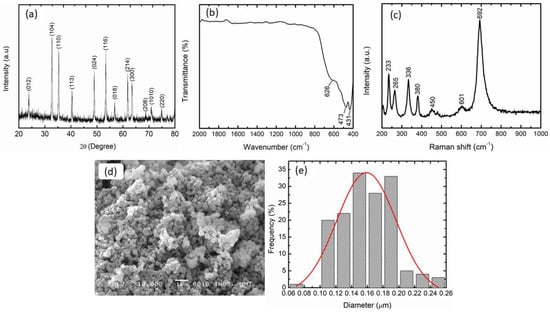
Figure 1.
(a) XRD profile, (b) FTIR spectra, (c) Raman spectra, (d) SEM image, and (e) particle size distribution of as-synthesized CoTiO3.
3.2. Hydrogen Storage Properties
The catalytic activity of the as-prepared CoTiO3 on MgH2 was studied by TPD experiments, as depicted in Figure 2a. The performance of the modified MgH2 with CoTiO3 was significantly enhanced compared to undoped MgH2. In terms of decomposition temperature, commercial MgH2 started decomposing at 420 °C, whereas as-milled MgH2 started at approximately 340 °C. This outcome implies that the process of ball milling for 1 h is beneficial in lowering the decomposition temperature of MgH2 as it decreased by 80 °C when compared with commercial MgH2. This result is consistent with a prior study that found that enhanced performance of metal/complex hydride is due to the milling process, which is effective in refining the particle size [49]. The milling process in essential in reducing the particle size, which contributes to the decrease of the decomposition temperature. However, the milling process would become inefficient in reducing particle sizes when the equilibrium between cold-welding and fracturing is achieved [50]. A previous study also reported that increasing the milling time causes the decomposition temperature to shift to higher temperatures due to the agglomeration of particles and reduction of their free surface area [51]. After augmenting MgH2 with 5 wt.% of CoTiO3, the onset decomposition temperature downshifted to 298 °C. The reduction in the decomposition temperature was more significant when the amount of CoTiO3 was increased to 10 wt.%. The MgH2 + 10 wt.% CoTiO3 sample began to decompose at 275 °C. For the 15 wt.% CoTiO3-doped MgH2, the decomposition temperature was almost similar to the MgH2 + 10 wt.% CoTiO3. The influence of different wt.% on the performance of MgH2 was further explored with 20 wt.% of CoTiO3. The composite sample of MgH2 + 20 wt.% CoTiO3 also began to release hydrogen lower than undoped MgH2, which started to release at 295 °C. However, the onset decomposition for the MgH2 + 20 wt.% CoTiO3 was slightly higher than MgH2 + 10 wt.% CoTiO3. This outcome was comparable with a previous study that found that the decomposition temperature for the 15 wt.% and 20 wt.% SrFe12O19-doped MgH2 was slightly higher than MgH2 + 10 wt.% SrFe12O19 [52]. Sulaiman et al. [53] also claimed the same condition, where the decomposition temperature for the MgH2 + 50 wt.% Na3FeF6 was slightly higher than for MgH2 + 10 wt.% Na3FeF6 and MgH2 + 20 wt.% Na3FeF6. This condition may be due to the excessive catalyst that may block the diffusion path of hydrogen, which limits the hydrogen diffusion [54]. Even the temperature for the hydrogen release for the 20 wt.% of catalyst was higher than that for the 10 wt.%; the temperature for the MgH2 to release hydrogen doped with a different weight percentage of CoTiO3 was significantly reduced when compared with undoped MgH2. Of note is the fact that the presence of CoTiO3 could modify the performance of MgH2 and be beneficial in lowering the decomposition temperature of MgH2.
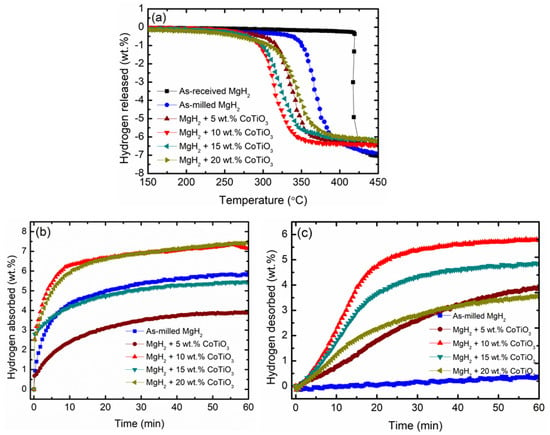
Figure 2.
(a) TPD, (b) hydrogen absorption at 200 °C under 33.0 atm H2 pressure, and (c) hydrogen desorption curve at 300 °C under 1.0 atm H2 pressure of the MgH2–CoTiO3 system.
The reversibility of the MgH2–CoTiO3 system was further studied via an absorption kinetic experiment conducted at a low temperature (200 °C). The doped sample was studied with a different weight percentage of CoTiO3, as demonstrated in Figure 2b. Among the four different wt.%, MgH2 + 10 wt.% CoTiO3 produces the fastest absorption rate and represents improved absorption kinetics performance than does undoped MgH2. As shown in Figure 2b, in the first 10 min, the as-milled MgH2 absorbed 4.3 wt.% H2, whereas the MgH2 + 10 wt.% CoTiO3 sample absorbed 6.4 wt.% H2. Even after completing the 60 min duration, the as-milled MgH2 could not attain as high capacity as that of the MgH2-doped 10 wt.% CoTiO3. In the meantime, the hydrogen absorbed for the 5, 15, and 20 wt.% of catalyst were 2.5, 4.1, and 6.0 wt.% H2, respectively, in the first 10 min. For the 5 wt.% of CoTiO3, the MgH2 + 5 wt.% CoTiO3 shows faster kinetics than milled MgH2 in the first 11s and intercept with the MgH2 at 12s and become slower than undoped MgH2. It can be concluded that the hydrogen absorption behavior was affected by the amount of catalyst. In the context of desorption kinetics, as depicted in Figure 2c, the MgH2-doped CoTiO3 composite displays a rapid desorption rate compared to undoped MgH2. Similar to the performance of the absorption kinetics, the MgH2 + 10 wt.% CoTiO3 presents a faster desorption kinetics rate compared to the 5, 15, and 20 wt.% CoTiO3-doped MgH2 samples. In the first 10 min, the undoped MgH2 roughly desorb hydrogen (<0.1 wt.%). Meanwhile, the MgH2 + 10 wt.% CoTiO3 sample desorbed at approximately 2.3 wt.% H2, which represents a 23-times-faster desorption rate when compared with undoped MgH2. In the same period, the 5, 15, and 20 wt.%-doped MgH2 desorbed 0.8, 1.8, and 1.2 wt.% H2, respectively, which is also faster than undoped MgH2. Table 1 summarizes the hydrogen storage behavior of undoped and doped MgH2 with a difference percentage of CoTiO3. Notably, low catalyst content is also beneficial in ameliorating the kinetics performances of MgH2. Similar to the TPD result, the MgH2 + 10 wt.% CoTiO3 performs the fastest absorption and desorption rate. These findings are in line with a previous study that demonstrated MgH2 + 0.5 mol Nb2O5 performs superior desorption kinetics than MgH2 doped with 0.05, 0.1, 0.2, and 1.0 mol Nb2O5 [55]. Similar to a study conducted by Ranjbar et al. [54], the desorption behavior of the MgH2 with 10 wt.% of SiC presents a faster desorption rate, which becomes slower when doping with 20 wt.% of SiC. They indicated that excessive catalysts in the composite may restrict the hydrogen diffusion to some extent, limiting the Mg–H reaction. From the findings, noticeably, the performance of MgH2 can be affected by the amount of the catalyst. By comprehensively considering the absorption/desorption hydrogen performance, the MgH2 with 10 wt.% of the CoTiO3 sample demonstrates the ultimate absorption/desorption performance. Thus, in this study, the MgH2 + 10 wt.% CoTiO3 sample is applied to examine the catalytic activity of CoTiO3 on the hydrogen storage behavior of MgH2. These results are similar to previous studies, in which 10 wt.% was an optimum amount of additive to provide a synergetic catalytic effect on the hydrogen storage performance of a metal hydride and a complex hydride [56,57]. Moreover, an excessive amount of additive may limit the diffusion of hydrogen to some extent, thereby reducing the reaction between the Mg and the hydrogen [54].

Table 1.
The hydrogen storage behavior of undoped and doped MgH2 with different weight percentage of CoTiO3.
The effect of CoTiO3 was further explored with the cycling performance of MgH2 + 10 wt.% CoTiO3, as shown in Figure 3. As reported previously, the cyclability of the undoped MgH2 is poor, where the performance would erode drastically after undergoing the first cycle [58]. Therefore, the cyclability of the undoped MgH2 is not included in this study because it desorbs only a small amount of hydrogen for the first cycle. Figure 3a shows the absorption kinetics curve of MgH2 + 10 wt.% CoTiO3 over the ten cycles. Surprisingly, after completing the 10th cycle, there is only a small amount of degradation in the hydrogen capacity for the absorption kinetics performance. The MgH2 + 10 wt.% CoTiO3 was able to absorb 7.1 wt.% H2 after the 10th cycle. Figure 3b shows the desorption kinetics curve of the MgH2 + 10 wt.% CoTiO3 for the ten cycles. The MgH2 + 10 wt.% CoTiO3 composite maintain good cyclability, with the ability to desorb 5.7 wt.% H2, even after completing the 10th cycle. It is evident that the addition of CoTiO3 is beneficial in maintaining a superior cyclability of MgH2.
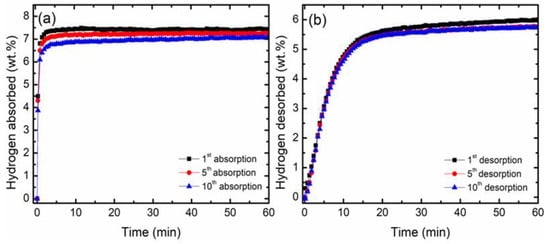
Figure 3.
Cycling performance of MgH2 + 10 wt.% CoTiO3 for (a) absorption kinetics curve at 320 °C under 33.0 atm H2 pressure and (b) desorption kinetics curve at 320 °C under 1.0 atm H2 pressure.
To explore the kinetics mechanism of the MgH2 + 10 wt.% CoTiO3 composite further, the sorption kinetics performance was analyzed using the kinetics model. For instance, a previous study has demonstrated the kinetic model characterization for the absorption/desorption time for the alloys materials [59,60]. A series of kinetics models have been widely explored and reviewed by Pang and Li [61] in their study. In this study, the kinetics mechanism was studied using Johnson–Mehl–Avrami (JMA) and contracting volume (CV) models, as indicated in Table 2. The JMA and CV models were considered because they are suitable for the experimental data and are precise without requiring further assumptions or approximations [61]. Moreover, other researchers have utilized this method extensively in prior studies to understand the rate-limiting step of the researched materials [62]. With kinetic equations such as CV and JMA, the rate-limiting step of the kinetics can be derived from the experimental data. In this study, the rate-limiting step is determined using the best linear plot of the experimental data with the kinetics equations.

Table 2.
Kinetic model used for sorption kinetics of current study, where α, t, and k refer to reacted fraction, time, and reaction rate constant, respectively. Based on [62].
Figure 4 present the kinetics curve that was calculated on the basis of the equation in Table 2. The absorption and desorption kinetics curves of the MgH2 + 10 wt.% CoTiO3 were calculated for reacted fractions ranging from 0% to 80% [63]. From the figure, for the absorption kinetics at 200 °C, the rate-limiting step is best represented using the 3D growth diffusion controlled with decreasing interface velocity, whereas the desorption kinetics of the MgH2 + 10 wt.% CoTiO3 at 300 °C was best described using the 2D growth of existing nuclei with constant interface velocity. These results suggest that hydrogen diffusion through the MgH2 + 10 wt.% CoTiO3 was fast. The nanosized CoTiO3 may be beneficial in allowing a faster dissociation rate of hydrogen and hence fasten the diffusion of hydrogen, which results in faster kinetic performance.
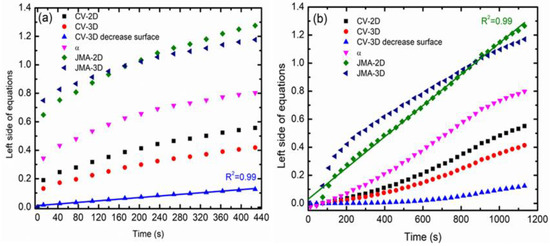
Figure 4.
Plot of the resulting curves of different kinetics equations applied to experimental (a) absorption kinetics at 200 °C and (b) desorption kinetics at 300 °C of MgH2 + 10 wt.% CoTiO3.
The thermal characteristics of MgH2 + 10 wt.% CoTiO3, performed using DSC (heating rate: 30 °C/min), are presented in Figure 5. The DSC trace demonstrates one endothermic peak correlated to the hydrogen release of MgH2. The peak of hydrogen release of MgH2 + 10 wt.% CoTiO3 happens at a lower temperature (382 °C) compared with as-milled MgH2 (445 °C), indicating that the dehydrogenation kinetics of MgH2 was enhanced by milling with CoTiO3.
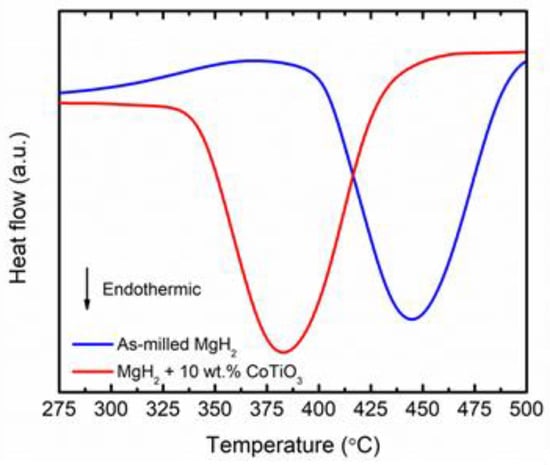
Figure 5.
Thermal event of as-milled MgH2 and MgH2 + 10 wt.% CoTiO3 (Heating rate: 30 °C/min) under 50 mL/min of Argon flow.
The enhancement in the dehydrogenation kinetic is associated with the energy barrier for hydrogen released from MgH2. In this study, the activation energy for hydrogen release from the doped and undoped MgH2 was evaluated using the DSC results. Figure 6a,b display the DSC curve of as-milled MgH2 and MgH2 + 10 wt.% CoTiO3 at four different heating rates. The Kissinger equation (Equation (2)) is used to evaluate the activation energy during decomposition.
where EA is the activation energy, R is the gas constant, Tp is the endothermic peak corresponding to the decomposition temperature, β is the heating rate, and A is a linear constant. Thereafter, the activation energy is determined on the basis of the Kissinger plot of ln [β/Tp2] versus 1000/Tp, as in Figure 6c. The activation energy of the MgH2 + 10 wt.% CoTiO3 and as-milled MgH2 were calculated to be 104.6 and 135.0 kJ/mol, respectively. The activation energy of MgH2 was decreased by 23% with the presence of CoTiO3 compared with undoped MgH2. Adding CoTiO3 into MgH2 remarkably reduces the energy barrier, which led to reduced activation energy and enhanced kinetic performance.
ln [β/Tp2] = −EA/RTp + A
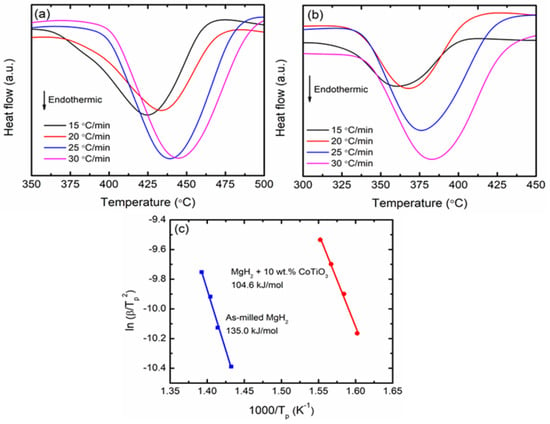
Figure 6.
DSC curve of (a) as-milled MgH2, (b) MgH2 + 10 wt.% CoTiO3 (Heating rate: 15, 20, 25, and 30 °C/min) and (c) Kissinger plot of undoped MgH2 and MgH2 + 10 wt.% CoTiO3.
Lower activation energy provided the reduction in the desorption barrier, which results in a dramatic decrease in the decomposition temperature. Low decomposition temperature indicates the weakening of the hydride stability [64]. As the bond energy of the Mg–H is the decisive factor in hydride stability, the reduction in hydride stability is attributed to the bond weakening between Mg and H. Typically, the addition of transition metal elements or their oxides helps in decreasing the binding energy between the Mg and H due to the electron exchange process between the MgH2 and additives in oxidation or reduction reactions [65]. As reported by a previous study, adding a catalyst is the most favorable approach for promoting the dissociation of the Mg–H bond by lowering its bond energy, which then offers the reduction of the MgH2 stability and decomposition temperature [66]. Thus, it is reasonable to conclude that the addition of CoTiO3 is beneficial in promoting the superior performance of MgH2 by lowering the energy barrier.
The catalytic activity of CoTiO3 on the microstructure of MgH2 was further explored by SEM characterization. Figure 7 displays the micrograph of commercial MgH2, MgH2 after milling for 1 h, and MgH2 + 10 wt.% CoTiO3. Referring to Figure 7a, commercial MgH2 are irregular in shape, with solid flake-like shaped particles. After being milled for 1 h (Figure 7c), the solid flake-like shaped particles were broken into smaller particles with some agglomerations. Before the milling process, the comparatively smooth surface of the particle is substituted by the asperities and surface defects. Because of these transformed surface structures, as-milled MgH2 decomposes at a lower temperature than commercial MgH2. Meanwhile, upon the addition of CoTiO3 (Figure 7e), the agglomeration was reduced, and the particle size was transformed to a finer shape and size. The size of the MgH2 + 10 wt.% CoTiO3 was much smaller than ball milled MgH2 due to the hardness of CoTiO3, which is higher than MgH2. The hardness of the MgH2 was 0.58 GPa [67], while the hardness of CoTiO3 was 3.4–7.5 GPa [68]. Therefore, it is speculated that the CoTiO3 introduced the pulverization effect and helped to reduce the particle size of MgH2. The particle size of MgH2 + 10 wt.% CoTiO3 is smaller, and they are finer in shape, even after undergoing the absorption (Figure 7g) and desorption (Figure 7i) process. No big changes occur on the particle after undergoing the absorption and desorption process. From the morphological properties, the CoTiO3 is able to reduce the particle size of MgH2 and enhances the absorption/desorption performance of MgH2. The differences of the microstructure and morphologies of the undoped and doped MgH2 may correspond to the presence of a catalyst that is finely dispersed on the surface of the MgH2 particle, thus reducing the H diffusion distance and offering more reaction site and hence stimulating the faster absorption and desorption performance of MgH2 [69]. This catalyst is embedded on the surface of MgH2 and prevent the sample from agglomerating, indicating that CoTiO3 is beneficial in distributing particles and constraining agglomeration and particle growth in the MgH2 system [22].
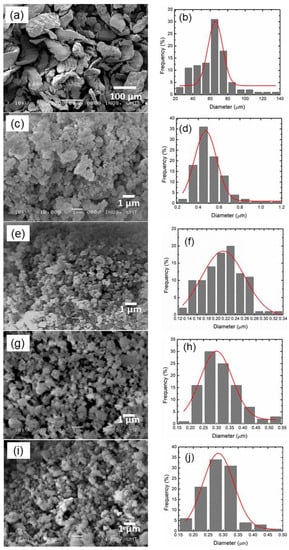
Figure 7.
SEM images and particle size distribution histogram of commercial MgH2 (a,b), as-milled MgH2 (c,d), MgH2 + 10 wt.% CoTiO3 after milling (e,f), MgH2 + 10 wt.% CoTiO3 after absorption at 200 °C (g,h), and MgH2 + 10 wt.% CoTiO3 after desorption at 450 °C (i,j).
The particle size of the commercial MgH2, as-milled MgH2, MgH2 + 10 wt.% CoTiO3 after milling as well as after absorption and desorption were further evaluated by Image J software. Figure 7b,d,f,h,j shows the distributions of the particle size, which are depicted in a histogram. Based on the histogram, the average particle size of commercial MgH2, as-milled MgH2, MgH2 + 10 wt.% CoTiO3 after milling, after absorption, and after desorption was calculated to be ~60, 0.47, 0.22, 0.29, and 0.28 µm, respectively. The morphological change and drastic size reduction contribute to the high surface defects and more grain boundaries around the surface of the composite [70]. Consequently, a higher amount of reaction for the nucleation sites and better diffusion channels for the hydrogen can be achieved with amplified grain boundaries that enhance the hydrogen sorption performances of the MgH2–CoTiO3 composite. Similarly, a recent study found that reducing particle size improves absorption–desorption kinetics performance substantially [71,72].
To reveal the catalytic mechanism of CoTiO3 for MgH2, XRD analysis for MgH2 + 10 wt.% CoTiO3 was performed, as in Figure 8. The main peaks that existed after 1 h of milling (Figure 8a) were only MgH2 and CoTiO3. No new phase was detected, indicating that no chemical reaction occurs during the milling process. Figure 8b presents the sample of the MgH2 + CoTiO3 after desorption at 450 °C. Peaks of Mg were dominant, indicating that MgH2 has been totally transformed to Mg, corresponding to the complete decomposition of MgH2, as in (Equation (3)). Additionally, the peaks of MgO and MgTiO3 could be detected after dehydrogenation.
MgH2 ↔ Mg + H2
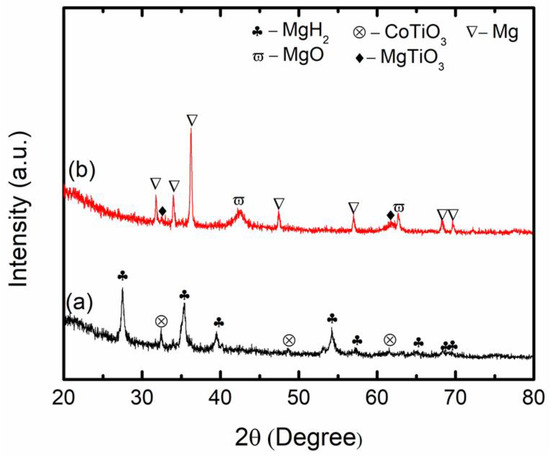
Figure 8.
XRD patterns of (a) as-milled and (b) after desorption at 450 °C of MgH2 + 10 wt.% CoTiO3.
To further explore the catalytic mechanism of CoTiO3 during desorption, a sample of MgH2 + 50 wt.% CoTiO3 was prepared. As displayed in Figure 9a, after 1 h of milling, only the parent materials, MgH2 and CoTiO3, were detected. No new compound was formed at this stage. After the desorption process at 450 °C (Figure 9b), the peaks of MgH2 and CoTiO3 disappeared and new peaks of MgO, MgTiO3, CoMg2, and CoTi2 appeared.
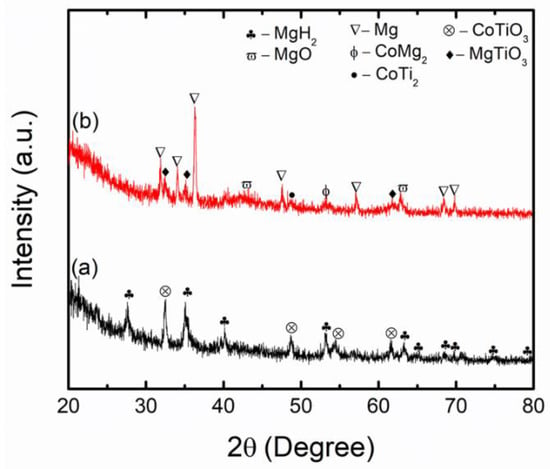
Figure 9.
XRD patterns of (a) as-milled and (b) after desorption at 450 °C of MgH2 + 50 wt.% CoTiO3.
Figure 10 presents the MgH2 + 10 wt.% CoTiO3 and MgH2 + 50 wt.% CoTiO3 sample after absorption at 200 °C. For the MgH2 + 10 wt.% CoTiO3 sample (Figure 10a), the main peaks of MgH2 were discovered, demonstrating that the Mg was fully converted to MgH2, as per Equation (3). The peaks of MgO and MgTiO3 were still detected. The appearance of the MgO and MgTiO3 species occurred, indicating that MgH2 reacts with CoTiO3 throughout the heating process. For the MgH2 + 50 wt.% CoTiO3 sample, similar peaks are presented in the absorption sample (Figure 10b), which are the Mg peaks superseded by the MgH2. New peaks of MgO, MgTiO3, CoMg2, and CoTi2 were also detected, suggesting that interaction between MgH2 and CoTiO3 may occur during the heating process, as indicated in (Equation (4)). The mechanism of the absorption/desorption process of the MgH2–CoTiO3 system is shown in Figure 11.
11MgH2 + 3CoTiO3 → 6MgO + MgTiO3 + 2CoMg2 + CoTi2 + 11H2
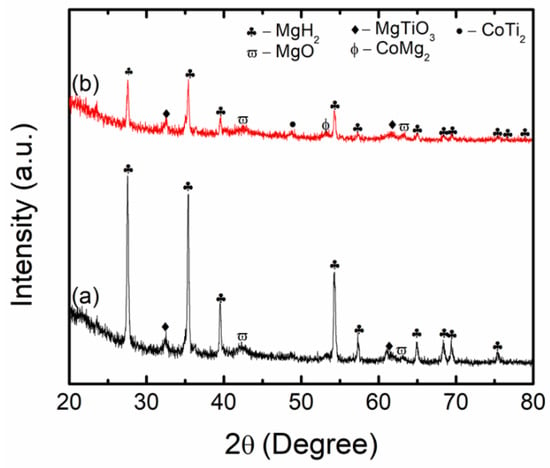
Figure 10.
XRD patterns of (a) MgH2 + 10 wt.% CoTiO3 and (b) MgH2 + 50 wt.% CoTiO3 after the absorption process at 200 °C.
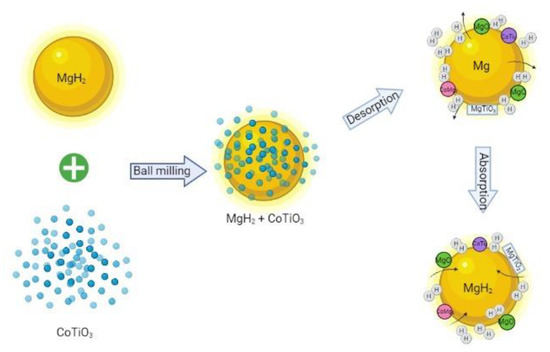
Figure 11.
Schematic diagram of the catalytic mechanism of CoTiO3 during the absorption/desorption process of the MgH2–CoTiO3 system. During the milling process, the MgH2 matrix reacts with CoTiO3. After undergoing the absorption and desorption process, MgTiO3, MgO and CoTi2, and CoMg2 are formed in situ. These in situ active species may serve as an intermediate transfer getaway that accelerates the hydrogen absorption and desorption of MgH2. With the assistance of in situ formed MgTiO3, MgO and CoTi2, and CoMg2, the hydrogen storage behavior of MgH2 is significantly improved.
On the basis of the above result, we postulate that the MgH2–CoTiO3 system presents a superior hydrogen storage performance of MgH2 due to the synergetic effect of the in situ formation of MgTiO3, CoMg2, CoTi2, and MgO. These active species act like active sites at the surface of the MgH2 matrix and provide a fast channel for the diffusion of H atoms in the absorption and desorption process [73,74]. For instance, a previous study stated that adding MgTiO3 ameliorates the sorption kinetics performance of MgH2 [75]. The MgH2 + MgTiO3 absorbed 5 wt.% of H2 in 500 s at 307 °C. Gao et al. [69] also presented the notable performance of MgH2 with the formation of Co-containing material after the desorption and absorption processes. It is believed that 3D electron orbitals in the transition metal stimulate the dissociation of H2 molecules by serving as the antibonding of H2 molecules. Thereafter, Ares-Fernandez and Aguey-Zinsou [50] presented faster absorption/desorption rates of MgH2 when it was doped with MgO. In another work, they stated that MgO may take part as a process control agent that can reduce and prevent MgH2 from agglomerating by achieving an optimal breakage rate [76]. The catalytic effect of MgTiO3, CoMg2, CoTi2, and MgO could work together to provide a synergetic effect and further boost the performance of MgH2. Nevertheless, more research is needed, such as applying X-ray photoelectron spectroscopy and high-resolution transmission electron microscopy, to elucidate the catalytic function of CoTiO3 on the hydrogen storage properties of MgH2.
4. Conclusions
The hydrogen storage performance of MgH2 was enhanced with the addition of nanosized CoTiO3, which was synthesized via the solid-state method. The different weight percentage of CoTiO3 was added into MgH2, and the 10 wt.% of the CoTiO3-doped MgH2 sample present a superior performance of hydrogen storage properties. The MgH2 + 10 wt.% CoTiO3 started releasing hydrogen at a temperature of 275 °C, 65 °C lower than as-milled MgH2 (340 °C). The MgH2 + 10 wt.% CoTiO3 composite also presents a faster absorption and desorption rate when it can absorb 6.4 wt.% H2 in the first 10 min and performs a 23-times-faster desorption rate when compared with as-milled MgH2. Moreover, the activation energy of the MgH2 decreased from 135 kJ/mol to 104.6 kJ/mol after the addition of 10 wt.% of CoTiO3. Adding nanosized CoTiO3 also results in a smaller and fine particle that promotes the favorable improvement of MgH2 performance. The superior performance of MgH2 with the addition of CoTiO3 was also attributed to the in situ formation of MgTiO3, CoMg2, CoTi2, and MgO during the heating process, which offers a synergetic catalytic role in improving the performance of MgH2. These findings may be beneficial for the modification of the MgH2 system for solid-state hydrogen storage in the future.
Author Contributions
N.A.A., Writing—original draft, methodology, formal analysis; M.S.Y., writing—review and editing; N.S., writing—review and editing; M.F.M.D., writing—review and editing; M.I., supervision, writing—original draft. All authors have read and agreed to the published version of the manuscript.
Funding
This research was funded by Universiti Malaysia Terengganu through Golden Goose Research Grant (GGRG) (VOT 55190).
Institutional Review Board Statement
Not applicable.
Informed Consent Statement
Not applicable.
Data Availability Statement
The data presented in this study are available on request from the corresponding author.
Acknowledgments
The authors also appreciate Universiti Malaysia Terengganu for offering the facilities to conduct this project. Nurul Amirah Ali and Noratiqah Sazelee are grateful for the SIPP and BUMT scholarship provided by Universiti Malaysia Terengganu.
Conflicts of Interest
The authors declare no conflict of interest.
References
- Scovell, M.D. Explaining hydrogen energy technology acceptance: A critical review. Int. J. Hydrog. Energy 2022, 47, 10441–10459. [Google Scholar] [CrossRef]
- Endo, N.; Goshome, K.; Tetsuhiko, M.; Segawa, Y.; Shimoda, E.; Nozu, T. Thermal management and power saving operations for improved energy efficiency within a renewable hydrogen energy system utilizing metal hydride hydrogen storage. Int. J. Hydrog. Energy 2021, 46, 262–271. [Google Scholar] [CrossRef]
- Carmo, M.; Stolten, D. Chapter 4—Energy storage using hydrogen produced from excess renewable electricity: Power to hydrogen. In Science and Engineering of Hydrogen-Based Energy Technologies; De Miranda, P.E.V., Ed.; Academic Press: Cambridge, MA, USA, 2019; pp. 165–199. [Google Scholar]
- Pal, P.; Agarwal, S.; Tiwari, A.; Ichikawa, T.; Jain, A.; Dixit, A. Improved hydrogen desorption properties of exfoliated graphite and graphene nanoballs modified MgH2. Int. J. Hydrog. Energy 2022, in press. [Google Scholar] [CrossRef]
- Tarkowski, R.; Uliasz-Misiak, B. Towards underground hydrogen storage: A review of barriers. Renew Sust. Energy Rev. 2022, 162, 112451. [Google Scholar] [CrossRef]
- Sales of Hyundai Hydrogen Fuel Cells Nexo Pass 1K Unit Mark in 2019. Available online: https://www.greencarcongress.com/2019/05/20190521-nexo.html (accessed on 23 August 2022).
- Thomas, J.M.; Edwards, P.P.; Dobson, P.J.; Owen, G.P. Decarbonising energy: The developing international activity in hydrogen technologies and fuel cells. J. Energy Chem. 2020, 51, 405–415. [Google Scholar] [CrossRef] [PubMed]
- Durbin, D.; Malardier-Jugroot, C. Review of hydrogen storage techniques for on board vehicle applications. Int. J. Hydrog. Energy 2013, 38, 14595–14617. [Google Scholar] [CrossRef]
- Sun, Y.; Shen, C.; Lai, Q.; Liu, W.; Wang, D.-W.; Aguey-Zinsou, K.-F. Tailoring magnesium based materials for hydrogen storage through synthesis: Current state of the art. Energy Storage Mater. 2018, 10, 168–198. [Google Scholar] [CrossRef]
- Sakintuna, B.; Lamari-Darkrim, F.; Hirscher, M. Metal hydride materials for solid hydrogen storage: A review. Int. J. Hydrog. Energy 2007, 32, 1121–1140. [Google Scholar] [CrossRef]
- Murthy, S.S.; Kumar, E.A. Advanced materials for solid state hydrogen storage:“Thermal engineering issues”. Appl. Therm. Eng. 2014, 72, 176–189. [Google Scholar] [CrossRef]
- Tarhan, C.; Çil, M.A. A study on hydrogen, the clean energy of the future: Hydrogen storage methods. J. Energy Storage 2021, 40, 102676. [Google Scholar] [CrossRef]
- Bhattacharyya, R.; Mohan, S. Solid state storage of hydrogen and its isotopes: An engineering overview. Renew Sust. Energy Rev. 2015, 41, 872–883. [Google Scholar] [CrossRef]
- Zhang, F.; Zhao, P.; Niu, M.; Maddy, J. The survey of key technologies in hydrogen energy storage. Int. J. Hydrog. Energy 2016, 41, 14535–14552. [Google Scholar] [CrossRef]
- Weng, Z.; Retita, I.; Tseng, Y.-S.; Berry, A.J.; Scott, D.R.; Leung, D.; Wang, Y.; Chan, S. γ-MgH2 induced by high pressure for low temperature dehydrogenation. Int. J. Hydrog. Energy 2021, 46, 5441–5448. [Google Scholar] [CrossRef]
- Wang, J.; Du, Y.; Sun, L.; Li, X. Effects of F and Cl on the stability of MgH2. Int. J. Hydrog. Energy 2014, 39, 877–883. [Google Scholar] [CrossRef]
- Li, Q.; Yan, M.; Xu, Y.; Zhang, X.L.; Lau, K.T.; Sun, C.; Jia, B. Computational investigation of MgH2/NbOx for hydrogen storage. J. Phys. Chem. C 2021, 125, 8862–8868. [Google Scholar] [CrossRef]
- Zhang, X.L.; Liu, Y.F.; Zhang, X.; Hu, J.J.; Gao, M.X.; Pan, H.G. Empowering hydrogen storage performance of MgH2 by nanoengineering and nanocatalysis. Mater. Today Nano 2020, 9, 100064. [Google Scholar] [CrossRef]
- Ma, Z.; Panda, S.; Zhang, Q.; Sun, F.; Khan, D.; Ding, W.; Zou, J. Improving hydrogen sorption performances of MgH2 through nanoconfinement in a mesoporous CoS nano-boxes scaffold. Chem. Eng. 2021, 406, 126790. [Google Scholar] [CrossRef]
- Akbarzadeh, F.Z.; Rajabi, M. Mechanical alloying fabrication of nickel/cerium/MgH2 nanocomposite for hydrogen storage: Molecular dynamics study and experimental verification. J. Alloy. Compd. 2022, 899, 163280. [Google Scholar] [CrossRef]
- Fu, Y.; Zhang, L.; Li, Y.; Guo, S.; Yu, H.; Wang, W.; Ren, K.; Zhang, W.; Han, S. Effect of ternary transition metal sulfide FeNi2S4 on hydrogen storage performance of MgH2. J. Magnes. Alloy. 2022, in press. [Google Scholar] [CrossRef]
- Huang, H.; Yuan, J.; Zhang, B.; Zhang, J.; Zhu, Y.; Li, L.; Wu, Y. A noteworthy synergistic catalysis on hydrogen sorption kinetics of MgH2 with bimetallic oxide Sc2O3/TiO2. J. Alloy. Compd. 2020, 839, 155387. [Google Scholar] [CrossRef]
- Dan, L.; Hu, L.; Wang, H.; Zhu, M. Excellent catalysis of MoO3 on the hydrogen sorption of MgH2. Int. J. Hydrog. Energy 2019, 44, 29249–29254. [Google Scholar] [CrossRef]
- Valentoni, A.; Mulas, G.; Enzo, S.; Garroni, S. Remarkable hydrogen storage properties of MgH2 doped with VNbO5. Phys. Chem. Chem. Phys. 2018, 20, 4100–4108. [Google Scholar] [CrossRef] [PubMed]
- Wang, S.; Gao, M.; Yao, Z.; Xian, K.; Wu, M.; Liu, Y.; Sun, W.; Pan, H. High-loading, ultrafine Ni nanoparticles dispersed on porous hollow carbon nanospheres for fast (de) hydrogenation kinetics of MgH2. J. Magnes. Alloy. 2021, in press. [Google Scholar] [CrossRef]
- Lu, Z.-Y.; Yu, H.-J.; Lu, X.; Song, M.-C.; Wu, F.-Y.; Zheng, J.-G.; Yuan, Z.-F.; Zhang, L.-T. Two-dimensional vanadium nanosheets as a remarkably effective catalyst for hydrogen storage in MgH2. Rare Met. 2021, 40, 3195–3204. [Google Scholar] [CrossRef]
- Youn, J.-S.; Phan, D.-T.; Park, C.-M.; Jeon, K.-J. Enhancement of hydrogen sorption properties of MgH2 with a MgF2 catalyst. Int. J. Hydrog. Energy 2017, 42, 20120–20124. [Google Scholar] [CrossRef]
- Sun, Z.; Lu, X.; Nyahuma, F.M.; Yan, N.; Xiao, J.; Su, S.; Zhang, L. Enhancing hydrogen storage properties of MgH2 by transition metals and carbon materials: A brief review. Front. Chem. 2020, 8, 552. [Google Scholar] [CrossRef]
- Zhang, Q.; Wang, Y.; Zang, L.; Chang, X.; Jiao, L.; Yuan, H. Core-shell Ni3N@ Nitrogen-doped carbon: Synthesis and application in MgH2. J. Alloy. Compd. 2017, 703, 381–388. [Google Scholar] [CrossRef]
- Liao, W.; Jiang, W.; Yang, X.-S.; Wang, H.; Ouyang, L.; Zhu, M. Enhancing (de)hydrogenation kinetics properties of the Mg/MgH2 system by adding ANi5 (A = Ce, Nd, Pr, Sm, and Y) alloys via ball milling. J. Rare Earths 2021, 39, 1010–1016. [Google Scholar] [CrossRef]
- Dong, J.; Panda, S.; Zhu, W.; Zou, J.; Ding, W. Enhanced hydrogen sorption properties of MgH2 when doped with mechanically alloyed amorphous Zr0·67Ni0.33 particles. Int. J. Hydrog. Energy 2020, 45, 28144–28153. [Google Scholar] [CrossRef]
- Zhang, L.; Wang, K.; Liu, Y.; Zhang, X.; Hu, J.; Gao, M.; Pan, H. Highly active multivalent multielement catalysts derived from hierarchical porous TiNb2O7 nanospheres for the reversible hydrogen storage of MgH2. Nano Res. 2020, 14, 148–156. [Google Scholar] [CrossRef]
- Berezovets, V.V.; Denys, R.V.; Zavaliy, I.Y.; Kosarchyn, Y.V. Effect of Ti-based nanosized additives on the hydrogen storage properties of MgH2. Int. J. Hydrog. Energy 2022, 47, 7289–7298. [Google Scholar] [CrossRef]
- Zhang, J.; Yan, S.; Xia, G.; Zhou, X.; Lu, X.; Yu, L.; Yu, X.; Peng, P. Stabilization of low-valence transition metal towards advanced catalytic effects on the hydrogen storage performance of magnesium hydride. J. Magnes. Alloy. 2020, 9, 647–657. [Google Scholar] [CrossRef]
- Huot, J.; Liang, G.; Boily, S.; Van Neste, A.; Schulz, R. Structural study and hydrogen sorption kinetics of ball-milled magnesium hydride. J. Alloy. Compd. 1999, 293–295, 495–500. [Google Scholar] [CrossRef]
- Hanada, N.; Ichikawa, T.; Fujii, H. Catalytic effect of nanoparticle 3d-transition metals on hydrogen storage properties in magnesium hydride MgH2 prepared by mechanical milling. J. Phys. Chem. B 2005, 109, 7188–7194. [Google Scholar] [CrossRef]
- Shang, C.; Bououdina, M.; Song, Y.; Guo, Z. Mechanical alloying and electronic simulations of (MgH2+ M) systems (M= Al, Ti, Fe, Ni, Cu and Nb) for hydrogen storage. Int. J. Hydrog. Energy 2004, 29, 73–80. [Google Scholar] [CrossRef]
- Yan, N.; Lu, X.; Lu, Z.; Yu, H.; Wu, F.; Zheng, J.; Wang, X.; Zhang, L. Enhanced hydrogen storage properties of Mg by the synergistic effect of grain refinement and NiTiO3 nanoparticles. J. Magnes. Alloy. 2021, in press. [Google Scholar] [CrossRef]
- Shan, J.; Li, P.; Wan, Q.; Zhai, F.; Zhang, J.; Li, Z.; Liu, Z.; Volinsky, A.A.; Qu, X. Significantly improved dehydrogenation of ball-milled MgH2 doped with CoFe2O4 nanoparticles. J. Power Sources 2014, 268, 778–786. [Google Scholar] [CrossRef]
- Ismail, M.; Mustafa, N.S.; Ali, N.A.; Sazelee, N.A.; Yahya, M.S. The hydrogen storage properties and catalytic mechanism of the CuFe2O4-doped MgH2 composite system. Int. J. Hydrog. Energy 2019, 44, 318–324. [Google Scholar] [CrossRef]
- Huang, X.; Xiao, X.; Wang, X.; Wang, C.; Fan, X.; Tang, Z.; Wang, C.; Wang, Q.; Chen, L. Synergistic catalytic activity of porous rod-like TMTiO3 (TM= Ni and Co) for reversible hydrogen storage of magnesium hydride. J. Phys. Chem. C 2018, 122, 27973–27982. [Google Scholar] [CrossRef]
- Idris, N.; Mustafa, N.; Ismail, M. MnFe2O4 nanopowder synthesised via a simple hydrothermal method for promoting hydrogen sorption from MgH2. Int. J. Hydrog. Energy 2017, 42, 21114–21120. [Google Scholar] [CrossRef]
- Kitchamsetti, N.; Choudhary, R.J.; Phase, D.M.; Devan, R.S. Structural correlation of a nanoparticle-embedded mesoporous CoTiO3 perovskite for an efficient electrochemical supercapacitor. RSC Adv. 2020, 10, 23446–23456. [Google Scholar] [CrossRef]
- Sharma, Y.K.; Kharkwal, M.; Uma, S.; Nagarajan, R. Synthesis and characterization of titanates of the formula MTiO3 (M=Mn, Fe, Co, Ni and Cd) by co-precipitation of mixed metal oxalates. Polyhedron 2009, 28, 579–585. [Google Scholar] [CrossRef]
- Habibi, M.H.; Shojaee, E. Ilmenite type nano-crystalline Co–Ti–O ternary oxides: Sol–gel thin film on borosilicate glass, characterization and photocatalytic activity in mineralization of reactive red 198. J. Mater. Sci. Mater. Electron. 2017, 28, 8286–8293. [Google Scholar] [CrossRef]
- Maensiri, S.; Laokul, P.; Klinkaewnarong, J. A simple synthesis and room-temperature magnetic behavior of Co-doped anatase TiO2 nanoparticles. J. Magn. Magn. Mater. 2006, 302, 448–453. [Google Scholar] [CrossRef]
- Rashad, M.M.; Elsayed, E.M.; Al-Kotb, M.S.; Shalan, A.E. The structural, optical, magnetic and photocatalytic properties of transition metal ions doped TiO2 nanoparticles. J. Alloy. Compd. 2013, 581, 71–78. [Google Scholar] [CrossRef]
- Acharya, T.; Choudhary, R.N.P. Structural, dielectric and impedance characteristics of CoTiO3. Mater. Chem. Phys. 2016, 177, 131–139. [Google Scholar] [CrossRef]
- Rattan Paul, D.; Sharma, A.; Panchal, P.; Chaudhary, S.; Patidar, D.; Nehra, S.P. Effect of ball milling and iron mixing on structural and morphological properties of magnesium for hydrogen storage application. Mater. Today 2021, 42, 1673–1677. [Google Scholar] [CrossRef]
- Ares-Fernández, J.-R.; Aguey-Zinsou, K.-F. Superior MgH2 kinetics with MgO addition: A tribological effect. Catalysts 2012, 2, 330–343. [Google Scholar] [CrossRef]
- Rahmaninasab, M.A.; Raygan, S.; Abdizadeh, H.; Pourabdoli, M.; Mirghaderi, S.H. Properties of activated MgH2+ mischmetal nanostructured composite produced by ball-milling. Mater. Renew Sustain. Energy 2018, 7, 15. [Google Scholar] [CrossRef]
- Mustafa, N.S.; Sulaiman, N.N.; Ismail, M. Effect of SrFe12O19 nanopowder on the hydrogen sorption properties of MgH2. RSC Adv. 2016, 6, 110004–110010. [Google Scholar] [CrossRef]
- Sulaiman, N.; Mustafa, N.; Ismail, M. Effect of Na3FeF6 catalyst on the hydrogen storage properties of MgH2. Dalton Trans. 2016, 45, 7085–7093. [Google Scholar] [CrossRef] [PubMed]
- Ranjbar, A.; Guo, Z.; Yu, X.; Wexler, D.; Calka, A.; Kim, C.; Liu, H. Hydrogen storage properties of MgH2–SiC composites. Mater. Chem. Phys. 2009, 114, 168–172. [Google Scholar] [CrossRef]
- Barkhordarian, G.; Klassen, T.; Bormann, R. Effect of Nb2O5 content on hydrogen reaction kinetics of Mg. J. Alloy. Compd. 2004, 364, 242–246. [Google Scholar] [CrossRef]
- Yahya, M.S.; Ismail, M. Catalytic effect of SrTiO3 on the hydrogen storage behaviour of MgH2. J. Energy Chem. 2019, 28, 46–53. [Google Scholar] [CrossRef]
- Sulaiman, N.; Ismail, M. Catalytic effect of SrFe12O19 on the hydrogen storage properties of LiAlH4. Int. J. Hydrog. Energy 2017, 42, 19126–19134. [Google Scholar] [CrossRef]
- Shriniwasan, S.; Kar, T.; Neergat, M.; Tatiparti, S.S.V. Mg–C interaction induced hydrogen uptake and enhanced hydrogen release kinetics in MgH2-rGO nanocomposites. J. Phys. Chem. C 2018, 122, 22389–22396. [Google Scholar] [CrossRef]
- Chou, K.-C.; Li, Q.; Lin, Q.; Jiang, L.-J.; Xu, K.-D. Kinetics of absorption and desorption of hydrogen in alloy powder. Int. J. Hydrog. Energy 2005, 30, 301–309. [Google Scholar] [CrossRef]
- Luo, Q.; An, X.-H.; Pan, Y.-B.; Zhang, X.; Zhang, J.-Y.; Li, Q. The hydriding kinetics of Mg–Ni based hydrogen storage alloys: A comparative study on Chou model and Jander model. Int. J. Hydrog. Energy 2010, 35, 7842–7849. [Google Scholar] [CrossRef]
- Pang, Y.; Li, Q. A review on kinetic models and corresponding analysis methods for hydrogen storage materials. Int. J. Hydrog. Energy 2016, 41, 18072–18087. [Google Scholar] [CrossRef]
- Barkhordarian, G.; Klassen, T.; Bormann, R. Kinetic investigation of the effect of milling time on the hydrogen sorption reaction of magnesium catalyzed with different Nb2O5 contents. J. Alloy. Compd. 2006, 407, 249–255. [Google Scholar] [CrossRef]
- Yonkeu, A.; Swainson, I.; Dufour, J.; Huot, J. Kinetic investigation of the catalytic effect of a body centered cubic-alloy TiV1.1Mn0.9 (BCC) on hydriding/dehydriding properties of magnesium. J. Alloy. Compd. 2008, 460, 559–564. [Google Scholar] [CrossRef]
- Zhang, Y.; Zhang, W.; Gao, J.; Wei, X.; Zhai, T.; Cai, Y. Improved hydrogen storage kinetics of Mg-based alloys by substituting La with Sm. Int. J. Hydrog. Energy 2020, 45, 21588–21599. [Google Scholar] [CrossRef]
- Sadhasivam, T.; Hudson, M.S.L.; Pandey, S.K.; Bhatnagar, A.; Singh, M.K.; Gurunathan, K.; Srivastava, O. Effects of nano size mischmetal and its oxide on improving the hydrogen sorption behaviour of MgH2. Int. J. Hydrog. Energy 2013, 38, 7353–7362. [Google Scholar] [CrossRef]
- Pighin, S.; Capurso, G.; Russo, S.L.; Peretti, H. Hydrogen sorption kinetics of magnesium hydride enhanced by the addition of Zr8Ni21 alloy. J. Alloy. Compd. 2012, 530, 111–115. [Google Scholar] [CrossRef]
- Nachev, S.; de Rango, P.; Skryabina, N.; Skachkov, A.; Aptukov, V.; Fruchart, D.; Marty, P. Mechanical behavior of highly reactive nanostructured MgH2. Int. J. Hydrog. Energy 2015, 40, 17065–17074. [Google Scholar] [CrossRef]
- Anderson, K.P.; Vinci, R.P.; Chan, H.M. Novel metal–ceramic composite microstructures produced through the partial reduction of CoTiO3. J Mater Sci 2018, 53, 8193–8210. [Google Scholar] [CrossRef]
- Gao, S.; Wang, X.; Liu, H.; He, T.; Wang, Y.; Li, S.; Yan, M. CNTs decorated with CoFeB as a dopant to remarkably improve the dehydrogenation/rehydrogenation performance and cyclic stability of MgH2. Int. J. Hydrog. Energy 2020, 45, 28964–28973. [Google Scholar] [CrossRef]
- Yuan, Z.; Sui, Y.; Zhai, T.; Yin, Y.; Luo, L.; Feng, D. Influence of CeO2 nanoparticles on microstructure and hydrogen storage performance of Mg-Ni-Zn alloy. Mater. Charact. 2021, 178, 111248. [Google Scholar] [CrossRef]
- Xie, X.; Hou, C.; Chen, C.; Sun, X.; Pang, Y.; Zhang, Y.; Yu, R.; Wang, B.; Du, W. First-principles studies in Mg-based hydrogen storage Materials: A review. Energy 2020, 211, 118959. [Google Scholar] [CrossRef]
- Ismail, M. Effect of adding different percentages of HfCl4 on the hydrogen storage properties of MgH2. Int. J. Hydrog. Energy 2021, 46, 8621–8628. [Google Scholar] [CrossRef]
- Malka, I.; Pisarek, M.; Czujko, T.; Bystrzycki, J. A study of the ZrF4, NbF5, TaF5, and TiCl3 influences on the MgH2 sorption properties. Int. J. Hydrog. Energy 2011, 36, 12909–12917. [Google Scholar] [CrossRef]
- Wang, P.; Tian, Z.; Wang, Z.; Xia, C.; Yang, T.; Ou, X. Improved hydrogen storage properties of MgH2 using transition metal sulfides as catalyst. Int. J. Hydrog. Energy 2021, 46, 27107–27118. [Google Scholar] [CrossRef]
- Pukazhselvan, D.; Nasani, N.; Yang, T.; Ramasamy, D.; Shaula, A.; Fagg, D.P. Chemically transformed additive phases in Mg2TiO4 and MgTiO3 loaded hydrogen storage system MgH2. Appl. Surf. Sci. 2019, 472, 99–104. [Google Scholar] [CrossRef]
- Aguey-Zinsou, K.F.; Ares Fernandez, J.R.; Klassen, T.; Bormann, R. Using MgO to improve the (de)hydriding properties of magnesium. Mater. Res. Bull. 2006, 41, 1118–1126. [Google Scholar] [CrossRef]
Publisher’s Note: MDPI stays neutral with regard to jurisdictional claims in published maps and institutional affiliations. |
© 2022 by the authors. Licensee MDPI, Basel, Switzerland. This article is an open access article distributed under the terms and conditions of the Creative Commons Attribution (CC BY) license (https://creativecommons.org/licenses/by/4.0/).